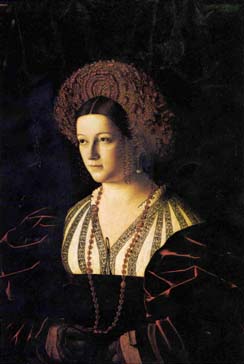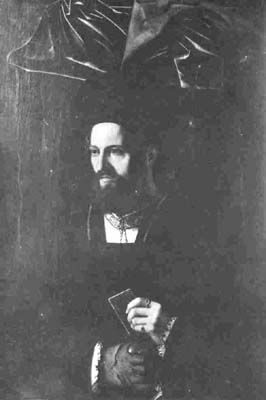
Bulletin 22, 1973
Home
Français
Introduction
History
Annual Index
Author &
Subject
Credits
Contact



Bartolommeo
Veneto and His Portrait of a Lady
by Creighton Gilbert
Résumé en français
Pages 1 | 2 |
3 | 4
| 5 | 6
| 7 | 8
| 9
A person is asking for
our recognition and attention (cover: fig. I). Though in a different
century and culture we have no difficulty at all in understanding
that this was the purpose of making an image of her. (1) It is ironic
that we have not only lost all knowledge of who she is, but that if
the information should appear it would be unlikely to make any
impression. We have shifted our approach, and the person to whom
we relate is the maker of the image. We are interested in the way he
went about it, and find the result worth treasuring; he was a good
craftsman and can be supposed to have met the sitter's wishes;
but did so in his own style, different from other artists' ways of
meeting the same kind of order. His name at one time was also
lost, and two hundred years ago a writer showed his approval of this
painting, and the shift of interest to the artist, in saying that it
was by Leonardo da Vinci. But then about ninety years ago,
historians began the work of putting together the fragments of
knowledge about Bartolommeo Veneto, who really did paint it, and
this portrait was one of those very soon recognized as his. His
personality is still full of puzzling gaps, but he is unmistakable
in this and about thirty other paintings that have been located in
various parts of the world.
The lady impels us to pay attention, to begin with, by dressing
splendidly. Bartolommeo paint translates this into large colourare
as, which acquire authority by their vibration, so that we
respond to them sensuously. A favorite choice, seen in paintings
of all phases of his career, is the deep translucent red, glowing
like coal through black shadows. (2) Its active but unified surface is
set against the cool receding green curtain, which, unlike most
portrait backgrounds in paintings of all periods, is neither flat nor
hazy, but another equally animated and vibrant colour area, whose
lighting, texture, and bumpiness of projection and recession
maintain the momentum of the foreground.
Such pictorial procedures say that the twentieth-century
counterpart to such painting is not to be found in our society
portrait painters, who often lean on the season's style as the
effective channel for asserting beauty and significance.
Bartolommeo's line leads rather to such painters of women as
Matisse, in whom textile ornament is part of the blend producing
sensuous life. Matisse's earliest direct ancestors, as a matter of
fact, are in the Venetian Renaissance, particularly Titian, and
Bartolommeo in part belongs to that same context. This less simple
linkage to the present illustrates a more general situation: in
the Renaissance the commissioned portrait was not yet saddled
with the implications of exploitative commercial art; it was an
active vehicle for the age's self-assertion, and perhaps the fullest
expression to be found in one place of two of its leading new
emphases: the observation of physical reality and the observation
of individual character. Thus it was entirely viable as an art
form. On the other hand, it is perfectly true that if we set Bartolommeo beside some other painters of his time the contrast
suggests a connection between his exceptional specialization in
this theme only and an effect of cooling down the life of his
figures to an unusual degree in the direction of rich ornament, so
that today the paintings that actually resemble his would be less
those of Matisse than those of a variety of less universal masters,
in whom we find again a narrow, sharp focus with colour areas of
elegant fmesse, e.g., Eugene Berman, Walter Murch, Yves Tanguy.
Single figures of richly dressed women do indeed make up a larger
part of Bartolommeo Veneto's work than that of any other Italian
painter of his time, so that he is interesting to analyze as an
exceptional person. (Such single figures are also a major vehicle,
to be sure, for other artists such as Titian, but in his case of
course must share the artist's attention with a much wider range of
others.) Some of Bartolommeo's women are portraits, others saints
or allegorical figures, and some are probably "fancy pictures," to
employ a useful term of the eighteenth century, the
great period for the categorizing of themes. (A "fancy
picture" shows a girl whose costume or pose provides us with a
title for the painting, but the pretty girl herself is the real
reason for making it. Greuze's work provides classic examples.) This
lady of Ottawa, among all of Bartolommeo's, has perhaps the quietest
face, so that her rich costume carries nearly all of the effect;
perhaps one might read the face as simply one more ornamental colour
area without a different order of life. His other women seem to
talk to us, turning their eyes to us, tilting their heads, smiling
about something, or holding up objects in their hands for us to see.
The difference in this neutral and passive lady is not the result, I
think, of the artist having changed his approach to a more
impersonal one, or one in which he makes the lady hide her feelings as if behind a
mask; (3) it is not likely that this would happen
just once, when the painting is otherwise quite typical as a
comparison with another portrait shows (see fig. 2). It might
rather be that this actually was a lady of calm and reserved
character, and is faithfully so shown as one more of the painter' s
many differentiated images. As an aspect of that possibility, or
as an alternative, we might think that this picture belongs to a
kind common in its period (but not known to exist in Bartolommeo's
work), half a pair of portraits of husband and wife. In such a case,
reduced expressiveness in the lady's face might be explained by
the social psychology of wives at this time (as in the last act of
Shakespeare's Taming of the Shrew), as well as the special
pictorial situation with two focuses, thus suggesting less stress in
each sitter. This possibility is raised because there is one male
portrait by Bartolommeo that seems to show us just what the other
half of the pair would look like. The Portrait of Master
Bernardino da Lesmo (fig. 2) belongs to about the same date in
Bartolommeo's career, is about the same size, and has a similar
design (with background curtain); but it shows the man turning to
the left, like the lady (and like most of Bartolommeo's sitters) so
it cannot be her husband, because a pair would face each other
symmetrically. (4)
A third explanation for the unusual face of the lady, that of
repainting, appears to be less plausible on closer inspection. The
X-rays, showing revisions on the surface, seem to show that only the
costume has been altered, as we shall see, and that the face has
been left wholly unchanged. The apparent differences of facial
expression, between X-ray and final surface, cannot be attributed to
any particular revision. Bach line is the same; hence the difference
in the photographic process seems to be responsible for this
effect.
Next Page | Mrs
Stella Newton
1 | 2 | 3 |
4
| 5 | 6
| 7 | 8
| 9
Annual Index | Author & Subject | Credits | Contact
This digital collection
was produced under contract to Canada's Digital Collections program,
Industry Canada.
"Digital
Collections Program, Copyright
© National Gallery of
Canada 2001"